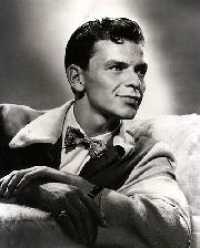Frank Sinatra has been called the greatest popular singer of the century. Whether that is true, in a century that also offers us Bing Crosby, Ella Fitzgerald and many others is, of course, a matter of personal emotional choice and, therefore, unknowable. What can be said is that under the intense and fickle scrutiny of the pop marketplace for nearly two-thirds of a century, Sinatra's music was in the air the world breathed and fell out of fashion only long enough for the deserters either to grow up or recognize that what was offered in its place was almost always trash by comparison.
Sinatra was born Dec. 12, 1915, in Hoboken, N.J., and as a schoolboy nursed ambitions to be a journalist. The earliest known example of Sinatra on record come from his 1935 performance on the Major Bowes Amateur Hour, in which he was matched with three other aspirants to sing "Shine." After the program they were sent out as a group, the Hoboken Four, on a Major Bowes road show.
Sinatra touched the big time in 1939 when Harry James, fresh out of the Benny Goodman band and not yet a major star in him own right, hired him to be vocalists in his new band. In August he recorded "All Or Nothing At All" with James, but the record would not become a major hit until Columbia reissued it during the recording ban in 1943. Sinatra was on a fast trajectory to the top himself. He left James to take an offer from Tommy Dorsey, with whom he recorded more than 90 songs before he left. The Dorsey years connected him to Axel Stordahl, who would arrange and conduct the first four Sinatra records under his own name in 1942 and become his chief musical architect for the next decade. He also made two movies with Dorsey, Las Vagas Night at Paramount and Ship Ahoy at MGM. But aside from two pictures with Gene Kelly, Sinatra's film career would be of passing interest until the 1950s.
The band singer period ended in September 1942. When Sinatra went out on as a soloist, it was to join the stock company of vocalists on the weekly "Lucky Strike Hit Parade." But there was buzz in the air about Sinatra, and it burst wide open when in 1943 when he was booked as a supporting act to Goodman at the Paramount Theater. Goodman introduced him, turned to kick off his band, and before he could lower his arm heard an ear-shattering scream of 3,000 mostly female fans explode behind him. "What they hell is that?" Goodman muttered.
During the bobby-sox years, Sinatra recorded for Columbia and turned out a steady flow of romantic ballads backed by Stordahl's tasteful orchestrations. But nothing as intense as the Sinatra phenomenon of the '40s could sustain indefinitely. The energy ran out of the Sinatra boom and by the 1952, it is said, he was washed up.
With the '40s behind him, however, the stage was set for his golden age. Capitol Records signed him up and concentrated on marketing him to young adults through carefully planned long playing albums organized around a mood, an idea, a feeling, a concept. In the Wee Small Hours, crafted by Nelson Riddle, became the matrix for his recording career from then on. Among the ballad albums, All Alone, arranged by Gordon Jenkins in 1962, stands in a class by itself for its stark sense of melancholy.
After Wee Small Hours, Sinatra turned to develop a side of his musical personality that had never been exploited -- the swinging Sinatra doing upbeat tempos against jazz-styled big band charts that caught some of the feeling that the new Count Basie band was generating on the instrumental side.
The albums and a string of successful films took Sinatra into the '60s at the top of his fame and form. He played the Newport Jazz Festival in the '60s, recorded with the Basie and Ellington, and played the Chairman to a colorful Clan that included Dean Martin, Sammy Davis and other chums. Talent was the admission ticket.
Yet, the force of youth movement and rock music in the late '60s and early '70s seemed to shake his own confidence in his own hipness, and he tried to embrace some of the new material. But after a period of retirement and a few false starts in the recording studio, he returned to form doing the kind of music that told stories worth telling. In the '90s his stubbornness paid off. The youth icons of the '60s and '70s finally came to him to sing his song on his terms. Duets may have received mixed critical reaction, but once again Sinatra was king of the hill, scoring the largest album sales of his career.
Sinatra received the Kennedy Center Honors in 1983. He died May 14, 1998, at the age of 82.
In 1998, Sinatra was elected by the Readers into the Down Beat Hall of Fame.
